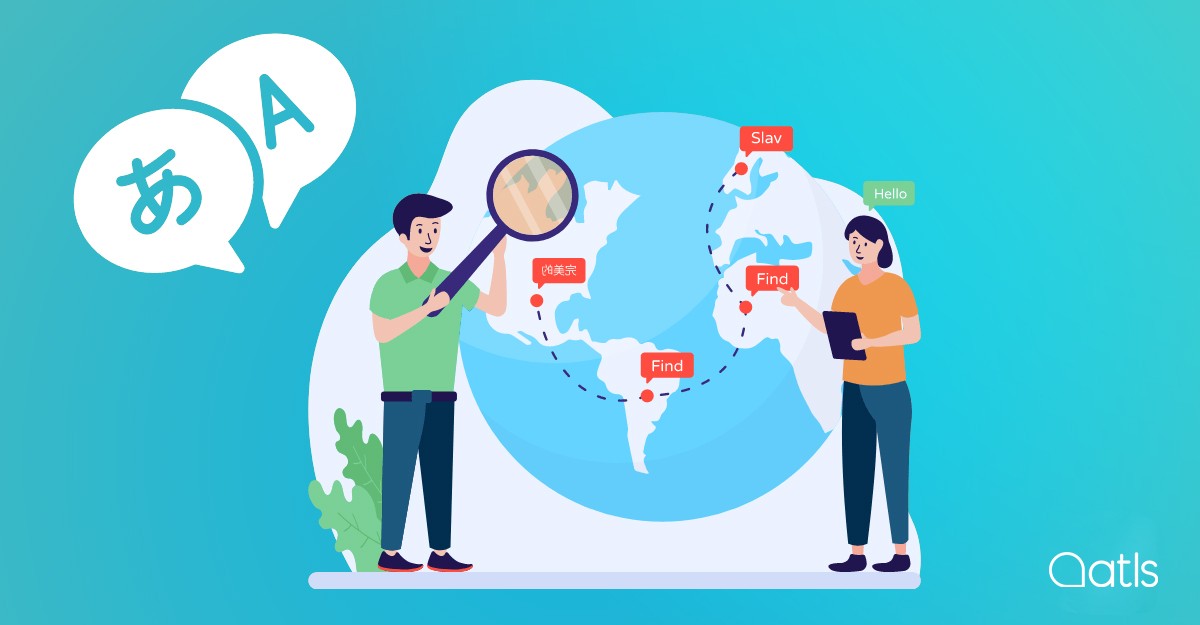10 international digital marketing strategies

Is your company ready to go global? There are many compelling reasons to expand your business into the international market:
- Increase in sales
- Improving brand reputation and knowledge
- Increase your competitive edge
The benefits are undeniable, but there are challenges to going global with your business. Here we tell you about the 10 best international digital marketing strategies for your business to make the leap to global level and achieve success in an increasingly competitive market.
Discover the top 10 international digital marketing strategies. Optimise your online presence today!
What is an international digital marketing strategy?
An international digital marketing strategy is the art of merging creativity and technology into a "dance" of digital strategies with the aim of winning over your target audience. In this game, international digital marketing becomes the key to unlocking the doors to business success. Through strategies such as SEO positioning, copywriting, email marketing and content on social media, you can reach the heart of consumers, creating lasting connections and generating impact on each click, like or share. In this digital world, where limits are blurred and opportunities are infinite, a well-executed international digital marketing strategy is the key to globalising businesses with all the guarantees of success.
Why is it necessary to develop international digital marketing strategies?
Developing international digital marketing strategies is essential in the current era, where online presence and digital interaction are crucial aspects for the success of any business. Digital marketing offers endless opportunities and benefits that are more difficult to find in traditional marketing methods.
Firstly, digital marketing allows you to reach a global audience instantly and effectively. Through tools such as social media, email marketing and search engines, companies can promote their products and services in a targeted and personalised way, reaching potential consumers anywhere in the world and at any time.
Digital marketing also offers greater measurement and analysis capacity. Web analysis tools and digital metrics allow companies to obtain detailed information on user behaviour, conversions, return on investment and other key performance indicators. This provides a solid basis for strategic decision-making and the optimisation of marketing campaigns.
Another important aspect is the possibility of interacting and establishing two-way communication with customers. Through social media, blog comments and online reviews, companies can listen and respond to their customers' needs and opinions, building strong relationships and promoting brand loyalty.
Digital marketing is highly scalable and adaptable. Companies can adjust and optimise their strategies in real time, according to the results obtained and market trends. It also offers precise segmentation and customisation options, which allows specific audiences to be addressed with relevant and persuasive messages.
In short, digital marketing strategies are necessary because they offer an effective way to reach the audience, they provide data and accurate information for decision-making, foster interaction and customer relations and enable constant adaptation to stay at the forefront of an increasingly digitised business environment.
Top 10 international digital marketing strategies
One of the most interesting things about working in the marketing sector is that year after year we have to turn what we are doing on its head in order to implement new trends and adapt to consumer habits. We are constantly learning and experimenting! What are the essential strategies you need to know about this sector? Let's take a look.
1. Create a multilingual website
One of the main challenges for expanding your business to another level is the language barrier. To overcome this obstacle, a key strategy is to transform your website into a multilingual site.
A website translated into several languages allows your potential customers, located in different parts of the world, to access your website and understand your products or services in their native language. This can also improve the user experience and increase your brand's confidence.
To create a multilingual website, you need to follow these steps:
- Identify the languages you need to include on your website. This will depend on the countries or regions you want to reach.
- Use a professional translation company to translate the content of your website into the corresponding language. Make sure that the company has translators with experience in the sector and are native to the target language.
- Use a plugin or content management tool to create multiple language versions of your website.
- Make sure that your website's SEO elements, such as meta tags and titles, are also translated correctly.
- Check that your multilingual website works well, and that browsing is simple and intuitive for your users.
Creating a multilingual website can be a laborious process, but it is a fully profitable investment if your goal is to expand globally.
2. International SEO strategy: optimise your website for search engines
To expand your business internationally, it is essential that you implement an international digital marketing strategy that includes the optimisation of your website for search engines in different languages and countries, also known as an international SEO strategy.
To achieve this, there are certain steps that you must take into account:
- Conduct a thorough research of keywords in each country or target region.
- Adapt the content of your website to each language and country.
- Create an internationally friendly URL structure.
- Use hreflang tags to indicate which version of your website is relevant for each country or language.
- Build international backlinks.
- Use specialised tools to monitor international SEO performance.
- Comply with local standards and regulations, monitor and analyse data to adjust your international SEO strategy on a regular basis.
It looks like a lot of work, and it is! For this reason, it is advisable to work with experts in international SEO to make sure you are implementing it correctly and obtain the best possible results. An international business will not achieve the desired success without an effective international SEO strategy. We tell you how it is, clearly and directly.
What are search engines?
Search engines are computer systems that collect the information stored on web servers and, when receiving a user's keyword, analyse these data to generate results in the form of links that satisfy the search. In other words, they provide a list of websites organised by importance and relevance, which contain the keyword. The most popular search engines are Google, Bing and Yahoo!.
The relevance of content, the quality of the website and the authority of the domain are common factors for classifying websites.
An effective SEO strategy can significantly improve your website's positioning in search results, resulting in more organic traffic, customers and conversions.
3. Search Engine Marketing (SEM): how to reach new international customers
SEM (Search Engine Marketing) is an effective strategy for reaching new international customers. Here are some tips on putting SEM into practice and making sure the result is the expected one.
- identify your business with the most relevant keywords: Before launching an SEM campaign, it is essential that you conduct an in-depth research of keywords. This will allow you to identify the phrases that users are using to search for products or services similar to yours.
- Create specific ads for each country: if you are trying to reach customers in different countries, it is important that you adapt your ads to each market. This means translating them into the local language, adjusting images and content according to cultural preferences and considering differences in competition and prices.
- Use international advertising platforms: There are several online advertising platforms that allow you to reach international audiences. Google AdWords is one of the most popular, but you can also consider options such as Bing Ads, Facebook Ads and LinkedIn Ads, depending on the target audience you want to impact with your ads.
- Conduct A/B tests to optimise your ads: Once you have created your ads, it is important that you conduct A/B tests to measure their effectiveness. This involves creating two versions of the same ad and assessing the best performance in terms of clicks, conversions and other key indicators.
- Use geographic segmentation: Most advertising platforms allow you to segment your ads by geographical location. This means that you can show your ads only to users in specific countries or even in cities or specific regions.
- Consider remarketing: if you already have an international customer base, remarketing can be a very effective strategy to reach them again. This means displaying ads to people who have already visited your website or interacted with your brand in the past.
- Analyse the data to improve your ROI: Finally, it is important that you regularly analyse the data of your SEM campaigns to identify areas for improvement and optimise your return on investment (ROI). Pay attention to indicators such as the cost per click and the conversion rate to make decisions on how to invest your resources.
4. Content marketing for different cultural audiences
To connect with cultural audiences around the world, it is essential to apply a content marketing strategy that takes into account cultural differences and adapts them accordingly. To achieve this, several strategies can be implemented:
- Research the local culture: It is important to know the customs, traditions, languages and values of each country or region before creating content.
- Adapt content to language: the translation should be precise and done by professional native translators.
- Choose appropriate images and colours: it is important to select those that are acceptable to local culture.
- Include cultural references: Incorporate cultural elements to demonstrate understanding of the local context.
- Customise the content: Create specific and valuable content for each audience.
- Consider format differences: Format preferences may vary depending on the culture.
- Maintain a coherent voice: Although the content is adapted to each culture, it is important to keep a uniform voice at all times.
- Use local influencers: collaborating with influential people at local level can increase the impact of content on specific audiences.
- Test and measure: Carry out tests to determine what type of content works best in each culture and use the data analysis results to adapt the strategy.
- Learn and evolve: Content marketing for different cultural audiences requires a constant process of learning and adaptation to remain at the forefront.
International copywriting
International copywriting is a persuasive writing technique that is used to communicate to global audiences in different languages and cultures. It consists of creating effective and persuasive content that captures the reader's attention and motivates them to take action, whether buying a product, subscribing to a service or carrying out any other desired action. International copywriting is crucial in the field of global marketing, as it allows messages to be adapted effectively to different international markets, considering the cultural, linguistic and emotional characteristics of each audience. By using international copywriting techniques, companies can maximise the impact of their marketing campaigns in different countries and generate more significant connections with their potential customers globally.
5. Affiliate marketing
Affiliate marketing is an online business model whereby the affiliates promote products or services from other companies in exchange for a fee for each sale or action carried out through their marketing efforts. Affiliates may be bloggers, website owners, influencers or anyone interested in generating additional income by promoting third-party products or services.
Affiliates use various promotional strategies, such as blogs, social media, email and websites, to attract potential customers and direct them to advertisers' products or services. When a user makes a purchase or action through the affiliate link, the affiliate receives an arranged fee.
This type of marketing offers a profitable opportunity for advertisers, who obtain greater visibility and sales, as well as for affiliates, who can generate additional income by promoting products or services that are aligned with their niche and audience. This technique is useful for expanding an international business through collaborations with local partners. To implement this strategy, the following steps should be followed:
- Identify your objectives: first of all, clearly define your objectives and what you want to achieve with affiliate marketing. Do you want to increase your sales in international markets? Do you want to improve your brand recognition in certain regions? Do you want to improve your relationships with local partners?
- Search affiliates who have a great scope in the regions you wish to expand to. As we have said, they can be bloggers, influencers, companies or websites specialising in your market niche.
- Establish a fee structure: Define a clear and attractive fee structure for your affiliates. This may include a percentage of sales or a fixed rate for each conversion generated.
- Provide tools and resources to your affiliates to help them promote your product or service, such as personalised links, advertising banners or exclusive content.
- Carry out monitoring and optimise and adjust your strategy if necessary. Use monitoring and analysis tools to measure the impact of your affiliates on your business.
In short, by working with local partners who have a great reach in the regions you wish to enter, you can increase your presence and sales in new markets effectively.
6. Influencer marketing: How can it help your international expansion?
Impacting an unknown market is quite complicated, as it is necessary to research and familiarise yourself with the consumption habits of online users. Reaching the potential customer organically takes a while. This is why, especially when arriving in a new region, it is advisable to opt for traffic through advertising both in search engines and in the target social media.
A formula that can obtain very positive results is to take advantage of the country's influencers or microinfluencers that are somehow linked to the business and to carry out campaigns through social networks with them. To effectively use this strategy, it is important to identify the appropriate influencers, establish clear objectives, create custom content and develop a long-term relationship.
7. Email marketing and automation for your international audience
To reach this desired international audience, it is essential to use tools such as email marketing and automation.
Benefits
- Planning: It allows you to schedule shipments at different times, depending on the country you work with.
- Statistics: A good tool shows the statistics to analyse them and extract a lot of information on the tastes and interests of your contacts, which allows you to improve future campaigns.
- Customisation: It allows you to create a totally customised campaign, promoting the most suitable products/services, news or promotions depending on the region you are targeting.
- A/B tests can also be conducted, to show which campaign is having the best acceptance or performance.
- Low costs: Email marketing is one of the most profitable marketing strategies, as it does not require a large budget to reach thousands of people anywhere in the world.
8. Manage social networks
Having a presence on social media is currently one of the most powerful tools. An effective international digital marketing strategy must include constant and meticulous management of these platforms. To do this, we recommend the following:
- Identify the most widely used social media in the countries where you want to expand and in the sector you specialise in and create very complete profiles.
- Publish relevant and quality content for your international audience. TAKE NOTE! Always with the content written or translated into the language of the market you are targeting.
- Interact with your followers and answer their comments and questions. Get interested in the audience you see.
- Use paid ads on social media to reach more audiences.
- Carry out competitions and prize draws to involve your audience and increase your brand's visibility.
- Create attractive visual content to capture the attention of your audience.
- Use relevant hashtags to reach a specific audience and increase the scope of your publications.
- Regularly monitor your social media statistics to assess the success of your campaigns and adjust them as necessary.
- As we mentioned above, collaborate with local influencers to reach a specific audience in a specific country.
- Use editing programming tools on social media to maintain a constant presence without this involving a lot of effort on your part.
9. Online reputation management Take care of your image in different countries and cultures
Every country and culture can perceive the company differently, so it's important to know the peculiarities of each and every market.
To take care of your company's online image in different countries and cultures, it is advisable to research and understand cultural differences; by using online reputation monitoring tools (Google Alerts, Mention or Brandwatch to mention a few), create relevant content for each market, use local social networks, maintain constant communication with your customers, be transparent and honest, pay attention to the quality of your products and services, learn from your mistakes and have patience.
These tips will help you adapt your international digital marketing and communication strategy to avoid possible misunderstandings or offences, detect problems and quickly respond to negative comments, reach new customers in different countries and build a positive online reputation.
10. Monitoring and measurement of your international results How do I know if I am having success?
Once the international digital marketing strategies we have described to your business have been applied, it is important that you monitor and manage your results to assess to what extent they have been successful or you must adjust them. To do so, this is our advice:
- Analyse your metrics: Use tools like Google Analytics to analyse metrics such as traffic, bounce rate, permanence time and conversion rate on your website.
- Conduct surveys: Send surveys to your international customers to get feedback on your products or services and their experience shopping on your website.
- Check your competition: Check what your international competitors are doing, this will give you an idea of how you are positioning yourself on the market.
- Use social media: Monitor the interaction with your brand on social media.
- Analyse your sales: Track your international sales and compare them with local sales
- Conduct A/B tests: to see which strategies work best.
- Use conversion tracking: Use conversion tracking tools to identify which pages generate more conversions.
- Analyse your advertising campaigns: Assess whether your advertising campaigns generate a positive return on investment.
- Monitor your keywords: to see if you are reaching your target audience.
- Make adjustments as necessary: use the information gathered to make changes to the established international digital marketing strategies.
International digital marketing strategies: examples
We want to give you several examples of companies that have successfully applied international digital marketing strategies:
- BuzzFeed: they are the kings of email marketing. They understand it's pretty difficult to position themselves, but they have opted for the customisation of email marketing and guess they've got it right! They send their segmented newsletters, which is why they have focused very well on each action and strategy. What have they been able to achieve with this? Send very good quality content to users who wish to receive it. (Source: Buzzfeed Newsletters)
- Glossier: This young people's makeup brand has achieved something that others have taken many years to achieve: to position itself on social media even before it launched its first product, placing a lot of emphasis on this type of marketing. But how have they managed to do it? To know their target audience very well and create a lot of naturalness in their publications by showing real situations with real people. (Source: Glossier Instagram account)
- Buffer: it is "THE TOOL" for social media programming. They started creating content on different websites in order to increase their visibility. This led to the attraction of its first 100,000 customers. They began to create high-quality content in their own blogs (yes, plural), and they were positioned as an authority in the field of marketing. They have two blogs where they create content on different topics. And if this wasn't enough, they also have a podcast where they talk about "The science of social media," sharing very interesting ideas on this subject. (Source: Buffer Blog)

From local to global
If you want to expand your business globally and achieve the success you deserve, contact our international digital marketing consultancy. Our 10 strategies will help you to reach new markets and increase your sales, while you build a solid and lasting online presence. Don't wait any longer to make the big leap towards international success. Contact us today and start growing!
Get in touch if you are interested in growing your business globally.











